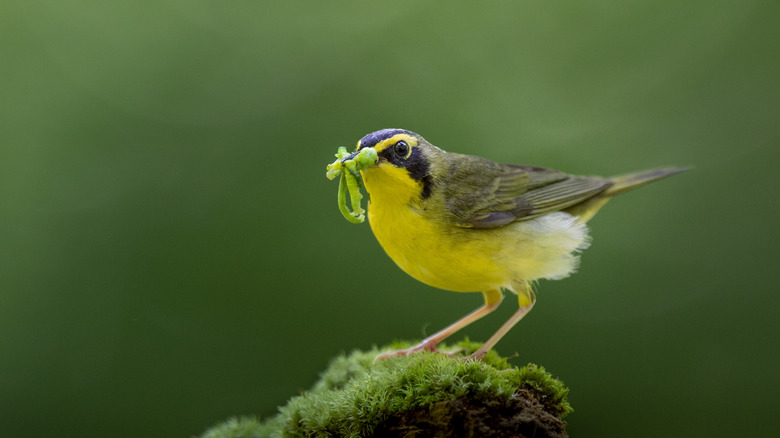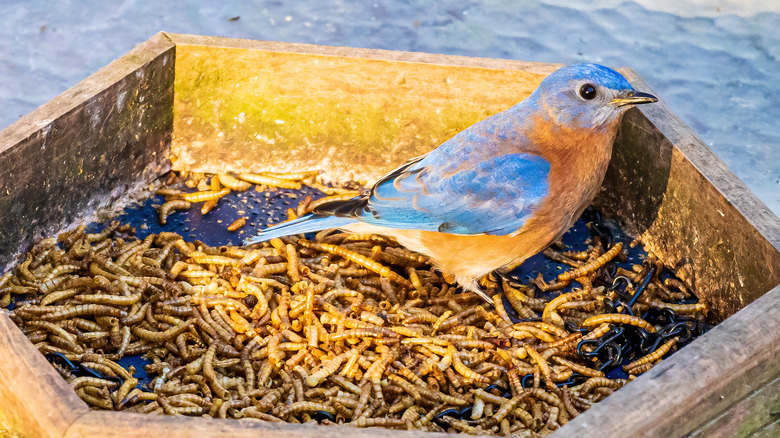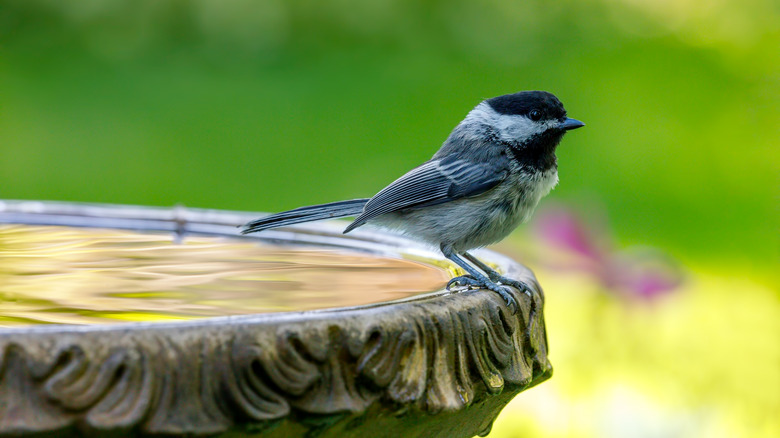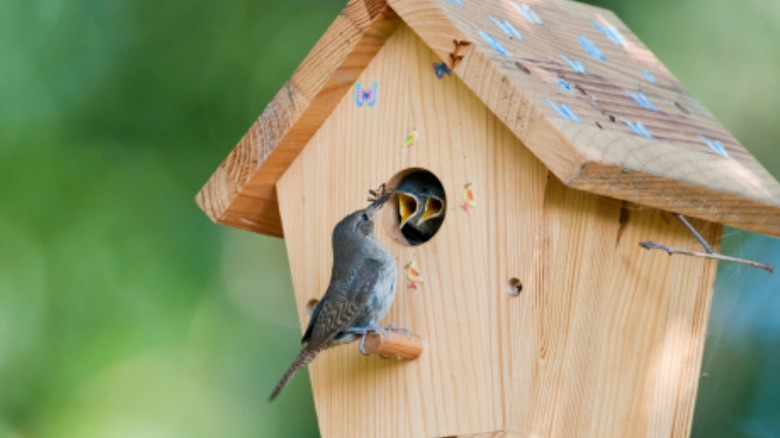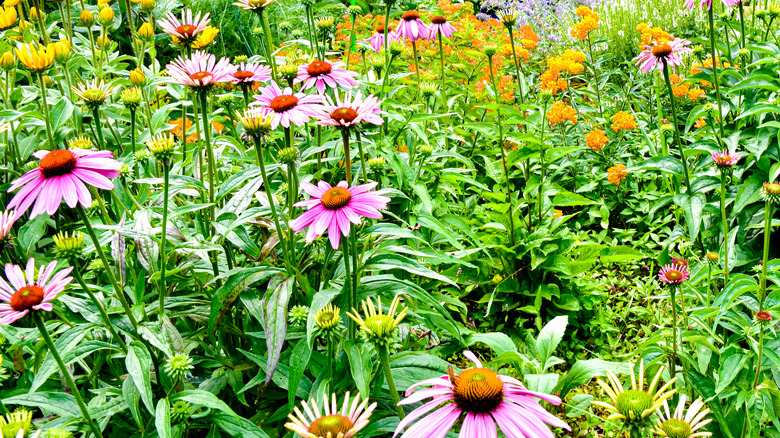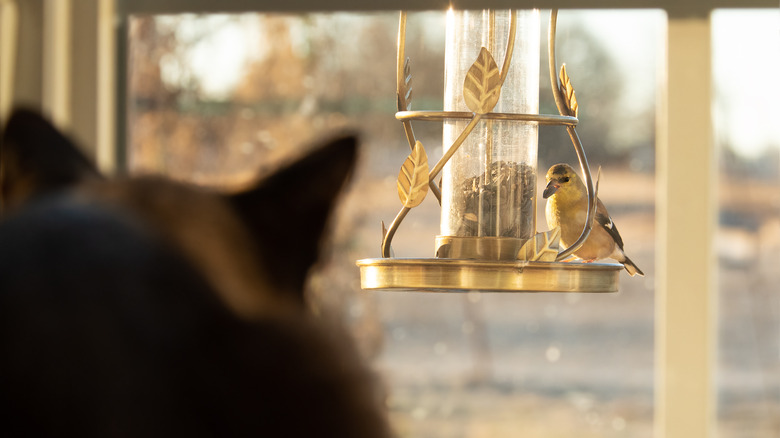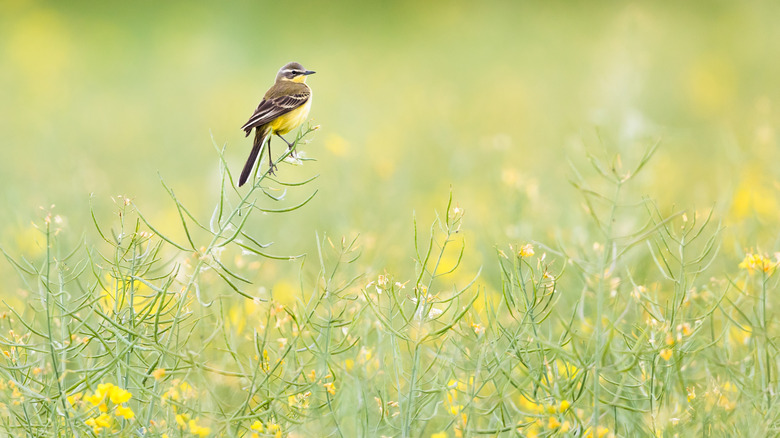Clever Tips To Attract Bug-Eating Birds To Your Yard
Woodpeckers. Titmice. Bluebirds. Wrens. Chickadees. What do these beloved backyard birds have in common? They eat insects. In North America, the vast majority of birds eat insects and feed them to their babies. While many birds are willing to vary their diets and have a sunflower seed snack at your bird feeder, their preference is for bugs – and for good reason. As described by entomologist Dr. Ashley Kennedy in a presentation for the Southern Maryland Audubon Society, bugs give birds a boost of protein and nutrition that young birds need to thrive.
Adding a bird feeder and filling it with seeds is probably the easiest way to see more birds in your yard, but how can you attract those birds who are on the hunt for bugs? Here are a few clever ways that you can not only attract a wider variety of fascinating backyard birds to entertain you when you look out the window, but also help support your local population of bug-eating birds.
Offer them bugs to eat
The most obvious solution for how to attract bug-eating birds to your feeder is to provide bugs for them to eat. While most easily available bird feed is a mix of other seeds, there is one alternative that can contain bugs: suet. These blocks of beef fat are attractive to birds who prefer bugs. Some even contain dead bugs like mealworms as a healthy treat for your avian guests. However, suet is only really a viable option in cold weather, as the hot summer sun can quickly make the suet go rancid, making a hazard for birds who may have melting fat drip onto them as they attempt to eat from it, and a disgusting mess for you to clean up.
An alternative to suet is to simply offer live mealworms as a snack for your backyard birds. These beetle larvae are packed with nutrients and are appealing to many birds, like bluebirds. Many bird lovers choose to put live larvae in hopper feeders, which are perfect for bluebirds, but a bowl or tin can will also work. If the idea of handling live bugs doesn't appeal to you, it's possible to buy dried mealworms, but the North American Bluebird Society warns that they may not be as appealing to birds. If you're going to use dried mealworms, you may have better luck if you soak them in water or vegetable oil before you put them out for the birds.
Just add water
If you can't provide food to insect eaters you can provide them with another vital resource: water.
If your yard doesn't already have a water source, adding a simple bird bath is one of the quickest ways to make your yard attractive to the birds who aren't interested in your feeder. Generally, it's best to choose a shallow bath, no more than 3 inches deep, so that small birds can get inside it to bathe if they want to. If you're going to have a bowl of water in your yard, though, it's vital that you keep it clean. All you need to do to keep the water safe for birds to drink is periodically rinse it out, and give it a scrub with a diluted vinegar solution. To keep mosquitoes from laying their eggs in it, you may also want to dump the water and refill the bath 3-4 times a week.
If you live in a cold climate, and you want to keep birds coming all winter, you should consider choosing a heated bird bath (or buy a separate heater) so it doesn't freeze over. To level up your bird bath all year long, try adding a water feature! A small fountain can keep mosquitoes away and birds will hear the sound of running water and come check out your yard.
Give them a place to live
Having birds to visit your yard can be wonderful, but what about having them live there? As described by Cornell Lab of Ornithology researcher Robyn Bailey in a presentation for the Wild Farm Alliance, nest boxes can be an excellent resource for insect-eating birds.
These can be placed on a pole, tree, or directly onto your home, possibly under an eave where it is protected from rain and high above humans and pets which may disturb them. The birds will be most attracted to nest boxes that are in quiet places that get dark at night, rather than directly under a porch light. When putting up a bird house or nest box, it's important to think about what baby birds will find when they're ready to hop outside and explore the outside world. One easy way to make their lives safer is to point the entrance away from roads.
Using a nest box to attract insect-eating birds to your yard can work well and really help your local bird population — but it is far from a quick fix. Birds only build nests in breeding season, and it can take a few years for your local birds to find your nest box and choose it as the best place to raise their young.
Think about your garden
While your bird feeder might not offer a wide variety of insects for bug loving birds to choose from, that doesn't mean that your yard can't! Anything from a small container garden to a massive tree can be a vital resource to birds and help bring more varieties to your yard.
While the idea of attracting bugs to your yard might seem strange to some, a wider range of insects in your yard means more food for the birds. Choosing plants that are native to your region supports more of the insects that birds crave. As explained by the Audubon Society, trees that have grown in your area for hundreds of years are naturally a part of the life cycle of hundreds of kinds of insects, while more exotic species do not. Some of the best options across North America include oak, willow, birch, and maple trees, and plants like goldenrod, milkweed, and sunflowers which are likely to get many juicy caterpillars for hungry young birds to eat. To find out what grows best in your region, you can use the Audubon Native Plants Database.
Different plants and trees appeal to different birds. As described by Audubon, those looking to attract grosbeaks, tanagers, and cardinals should choose serviceberries, while those who want to bring titmice and chickadees might be better off with a birch tree outside their home.
Keep them safe from predators
While woodpeckers hunt for bugs high in the trees, many insect eaters forage for bugs on the ground. If you want them to feel safe visiting your yard, they need to be protected from predators. Since you can't be around all the time shaking your fist at raptors, here are some easy ways to keep your birds safe while they hunt for worms.
Make sure that your yard has places to hide. Birds, like all little wild animals, are experts at dodging things that might try to eat them, but you can give them an advantage by providing some cover. This could mean planting shrubs, letting your grass grow long, or leaving a brush pile for them to hide in when they spot danger. This is particularly vital in the spring and summer, when fledgling birds are still figuring out how their wings work and may not be able to easily fly away from hungry predators.
The deadliest predator to your backyard birds might actually be a beloved member of your family: your cat. Every year, cats kill literally billions of birds around the world. One of the best things you can do for your local bird population, particularly your ground-feeding birds hunting for bugs, is to either keep your furry friend inside, or only letting them out onto a "catio" or with a harness on.
Transform your yard into a habitat
Birds have more needs than just food. If you're looking to bring more types of birds to your yard but don't necessarily have their favorite snacks, you can provide them with some of the other things they're looking for, instead. As many habitats are destroyed by human expansion and climate change, birds are increasingly desperate for safe places to call home. For some, that could be your backyard.
One of the best ways to make your yard a natural habitat is also one of the easiest: do less. To make their yards aesthetically appealing, people often put a lot of effort into mowing lawns and raking leaves — but if you want to attract birds of all kinds, leaving your yard more wild is a great place to start. Not cutting back plants after they flower lets birds enjoy the seeds. Not raking your autumn leaves creates a rich foraging ground for bug-eating birds. Leaving any fallen branches, logs, or pruned vegetation in a pile creates a safe place for birds to shelter from harsh weather and predators.
